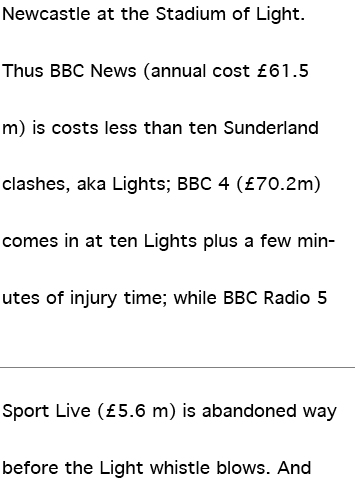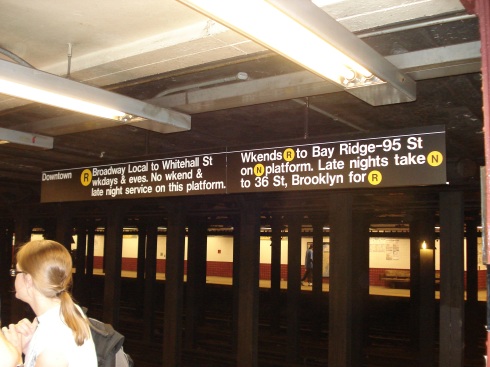I love it when our media commentator goes off on a theme. Editing writers who have let themselves off the leash is always enjoyable, and his stream-of-consciousness style is at its best when he’s got hold of a metaphor and is running with it.
This piece – only a 240-word sidebar to his main column – is about the BBC payoffs row: the large amount of licence-payers’ money given as golden goodbyes to departing executives and the furious backlash that has resulted from them. That money could have been spent on all sorts of worthwhile things, the media has chorused, using the usual benchmarks: Downton Abbey episodes, schoolbooks, hospital beds etc. Last week, though, the BBC came out fighting, and countered the criticism with a comparison of its own. As the media commentator puts it:
And that’s all the media commentator needs to mint a new currency of comparison, the unit of exchange being the cost of televising Sunderland v Newcastle at the Stadium of Light: one match equals one “Light”.
When writers have got the bit between their teeth, the standard advice for editors is to keep out of their way and let them flow. And that’s good advice on the whole: intervening to correct fragmented sentences or very long paragraphs can kill the whole experience, and bring “correctness” and “readability” at the expense of enjoyment. But mistakes – actual mistakes – are a different matter. Maybe it’s my dorkish sub-editor’s soul, but I can’t fully enjoy a comic or passionate rant when a dangling modifier points all the ire in the wrong direction or there’s a glaring malapropism in the punchline. A greengrocer’s apostrophe can spoil a joke almost as much as it spoils an editorial. So the skill, actually, is to intervene just enough – to unobtrusively correct a fact or a timeline, say. Or, in this case, to correct the arithmetic.
Let’s look at what a “Light” is worth again. If £3.8m is “about half of what of what other TV networks would pay for televising the first half of a Premiership football match”, that’s £3.8m per quarter, in effect, or £7.6m per half. The total cost of a match would be £7.6m x 2; therefore one Light equals £15.2m.
But that doesn’t seem to be how it works in the article. If BBC News costs £61.5m, that’s nowhere near as much as 10 Lights: more like four. Same with BBC4: £70.2m is less than 5 Lights, not more than 10.
And hang on a minute: did Lord Patten really say “half of what of what other TV networks would pay for televising the first half of a Premiership football match”? That’s a funny way to put it – a lot of halves. That’s actually strange enough to need some investigation.
And lo and behold, the original article proves that doesn’t appear to be what he said. Per the furniture:
Mystery solved. But wait – what’s this in the body text?
So, he did say half of a half? What’s going on here? I thought I was just on for a quick tidy-up of a 240-word sidebar. But now, out of nowhere, we’re into a full-blown re-investigation of a completely different article from another desk whose content is at variance with its furniture (and which is also short an apostrophe in the standfirst). Can’t just leave it like that. Sigh.
Right: further scrutiny of this new article has revealed an actual hard number we can work from:
Aha. So, allowing for typical politicians’ numerical exaggeration (and journalists are not in much of a position to criticise anyone else about that), £3.8m is indeed, roughly, the cost of televising half a Premier League match. Good: just need to email the media desk with suggested corrections for this piece, go back to my piece and write around the quote to fix it.
Except that – dammit – we’re still not quite there. If £3.8m is right (ish), the sums still aren’t. Look at the maths once again. The cost of BBC News, £61.5m, isn’t exactly “less than 10 Lights” if you take “less than 10” to mean nine-point-something and one Light to be £7.6m: it’s barely over eight. But it is pretty close if you go with the real £6.6m figure – which is mentioned nowhere in this piece. Moreover, BBC4’s budget of £70.2m isn’t “10 Lights and a bit of injury time” if one Light is £7.6m; and if one Light is £6.6m, it’s closer to 11 Lights than 10 – not just a bit of injury time but almost a whole extra hour.
Never judge an article by its word count. Man, why did I pick this one up?









